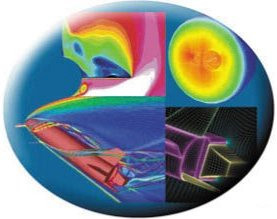

| News and Publications in 2006-2005
|
|
| 13 December 2006 Announcement: Talks by Jean-Marie Muylaert Head, Aerodynamics and Aerothermodynamics Section, European Space Agency, Noordwijk (Netherlands) Tuesday, 19th December 2006
Talk 2: 14:45 - 15:30 Questions and Discussions: 15:30 - 15:45 Location: Gebäude A, Raum A.1OG.02 Univ. of Applied Sciences Karl-Scharfenberg-Str. 55-57 38229 Salzgitter-Calbecht Directions: see http://www.fh-wolfenbuettel.de/cms/de/service/download/sz.pdf Contact: Prof. Dr. J. H??user jh@hpcc-space.de Tel.: (+49)5341-875-450 (201) |
|
| 24 August 2006 Artificial Gravitational Field Generated in the Laboratory? (pdf) |
|
| Spacetime
Physics and Advanced Propulsion Concepts. (remarks) As a follow up of the recent AIAA JCP meeting in July, a revised version of our invited AIAA 2006-4608 paper can be downloaded (5Mb,pdf) |
|
| New Book on
Numerical Grid Generation available: Selected Papers from 9th International Conference, June 12-15, 2005 on Numerical Grid Generation in Computational Field Simulations Published by International Society of Grid Generation ISGG Eds. P. Papadopoulos, J. Häuser, P. Eisemann, J. Thompson, B. Soni, R.-M. Spitaleri order through ISGG |
|
| 10 April 2006: Extended Heim Theory, Physics of Spacetime, and Field Propulsion In this non-mathematical overview we present a very brief introduction to some of the basic physical assumptions of Extended Heim Theory (EHT) as developed by Heim and Dröscher. We also explain the differences to the original 6-dimensional theory of Heim. These differences may be substantial, and we will show that a completely different picture of physical interactions is the result. EHT predicts six fundamental physical interactions. Heim had adopted Dröscher's idea of a 12-dimensional internal symmetry space from which the polymetric tensor, describing physical interactions, has to be constructed. Together with Dröscher, he published the book Strukturen der physikalischen Welt und ihrer nichtmateriellen Seite, Resch Verlag, 1996, Innsbruck, in which the physical consequences of this 12-dimensional internal space are discussed. Unfortunately, because of his failing health, Heim could not any more accomplish the task of rewriting his first two volumes on Elementarstrukturen der Materie, Resch Verlag, Innsbruck. The notes below are an excerpt from a forthcoming paper and are only a beginning (pdf 207kB). |
|
| March 2006: Prof. G.W. Bruhn, Dept. of
Mathematics, Technical University of Darmstadt, Germany, http://www.mathematik.tu-darmstadt.de/~bruhn/IGW.html
criticized that Eq. (2) in our paper AIAA 2004-3700, a4, letter, will lead to a flat metric. We have rejected his comments as being irrelevant to the physics of Heim theory, see pdf . In the following we present the physical basis of Heim theory in a nutshell:
|
|
| Our research work on advanced propulsion systems
based on field propulsion (Heim theory) was described in a
popular article by
New Scientist, 7-13 January 2006. However, not everything described there should be taken literally. The theoretical work is highly speculative, and it is not sure that there are three gravitational interactions in Nature as predicted by us. On the other hand, the benefits would be enormous if six fundamental physical interactions existed in Nature. |
|
| Dr. Häuser presented an invited lecture and
paper on Advanced Propulsion (Magnetohydrodynamics and Heim
Theory) at Sarod 8-9 December 2005, Hyderabad, India.
Proceedings published as: Recent Trends in Aerospace Design and Optimization, SAROD-2005, ed. B. Uthup, ISBN 0-07-060829-6, Tata Mc Graw-Hill, 2005. |
|
| Dröscher, W., Häuser, J. Heim Quantum Theory: Notation, Glossary and Mathematical Definitions ( pdf, 270kB) |
|
| Dröscher, W., Häuser, J. Magnet Experiment to Measuring Space Propulsion Heim-Lorentz Force a4, letter (pdf, 1.7 MB) Innsbruck, Austria, Faculty Karl-Scharfenberg, University of Applied Sciences, Salzgitter, Germany, 41st AIAA/ASME/SAE/ASEE Joint Propulsion Conference & Exhibit,Tucson,Arizona, 10-13 July,2005 |
|
| As of June 1, 2005 Prof. Häuser was elected
Visiting Scholar by the Aerospace and Mechanical Engineering
Dept. of San Jose State University, California |
|
| W. Droscher, IGW, Innsbruck and J. Hauser have
been selected to receive the AIAA Award for 2004, best paper by the Nuclear and Future Flight Technical Committee. This award will be presented at the 41st AIAA Joint Propulsion Conference in July 2005 |
|
| Talk by Prof. J. Häuser about Space
flight given at the International Junior University of
Salzgitter, 2005 Thursday, April, 21st. Vorlesung von Prof. J. Häuser an der Internationalen Junior-Universität Campus Salzgitter, 21. April 2005 "Raumfahrt - Was ist das" (pdf,1.6MB) |
|